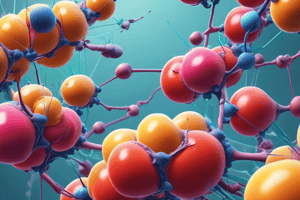Podcast
Questions and Answers
Glycolytic pathway regulation involves:
Glycolytic pathway regulation involves:
- allosteric stimulation by ADP
- allosteric inhibition by ATP
- feedback, or product, inhibition by ATP
- all of the above (correct)
In anaerobic conditions glycolysis will more efficient
In anaerobic conditions glycolysis will more efficient
- A. because the pathways is shorter
- B. glycolysis is not more efficient in anaerobic conditions (correct)
- C. because all the reactions occur in the cytoplasm
- D. because there is no requirement for ATP in the investment stage
. For every one molecule of sugar glucose
oxidized, how many molecules of pyruvic acid are
produced?
. For every one molecule of sugar glucose oxidized, how many molecules of pyruvic acid are produced?
- 1
- 4
- 2 (correct)
- 32
A kinase is an enzyme that
A kinase is an enzyme that
Which of the following statements about hexokinase is
not true?
Which of the following statements about hexokinase is not true?
Which of the following is not true of glycolysis?
Which of the following is not true of glycolysis?
The energy released by the oxidation of glucose is
stored as
The energy released by the oxidation of glucose is stored as
Why does the glycolytic pathway continue in the
direction of glucose catabolism?
Why does the glycolytic pathway continue in the direction of glucose catabolism?
The enzymes of glycolysis in a eukaryotic cell are
located in the
The enzymes of glycolysis in a eukaryotic cell are located in the
The glycolytic pathway (glucose → pyruvate) is found
The glycolytic pathway (glucose → pyruvate) is found
Flashcards are hidden until you start studying



